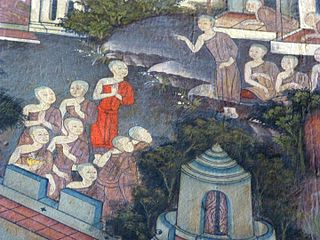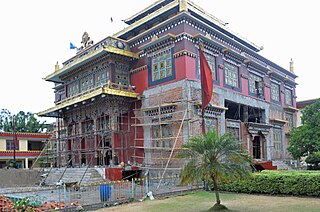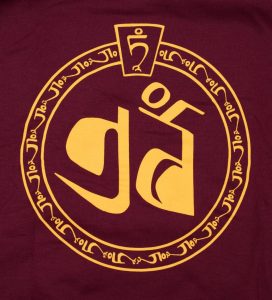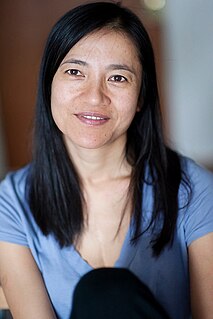Related Research Articles

Tibetan Buddhism is the form of Buddhism practiced in Tibet and Bhutan, where it is the dominant religion. It also has adherents in the regions surrounding the Himalayas, in much of Central Asia, in the Southern Siberian regions such as Tuva, and in Mongolia.

Padmasambhava, also known as Guru Rinpoche and the Lotus from Oḍḍiyāna, was a tantric Buddhist Vajra master from India who may have taught Vajrayana in Tibet. According to some early Tibetan sources like the Testament of Ba, he came to Tibet in the 8th century and helped construct Samye Monastery, the first Buddhist monastery in Tibet. However, little is known about the actual historical figure other than his ties to Vajrayana and Indian Buddhism.

Ogyen Trinley Dorje, also written as Urgyen Trinley Dorje is a claimant to the title of 17th Karmapa.

Lobsang Trinley Lhündrub Chökyi Gyaltsen was the tenth Panchen Lama, officially the 10th Panchen Erdeni, of the Gelug school of Tibetan Buddhism. According to Tibetan Buddhism, Panchen Lamas are living emanations of the buddha Amitabha. He was often referred to simply as Choekyi Gyaltsen.

Larung Gar in the Larung Valley is a community in Sêrtar County of Garzê Tibetan Autonomous Prefecture, in Sichuan, China, known of as Kham. Larung Gar is the local name for the community of mostly Tibetan and Han Chinese students which grew around the Serta Larung Five Science Buddhist Academy, founded in 1980 by Kyabje Khenchen Jigme Phuntsok. The residents are monks, nuns, vow holders and lay people. Larung Gar was considered the largest Buddhist monastic center until demolitions by the Chinese government recommenced in July 2016.
Geshe or geshema is a Tibetan Buddhist academic degree for monks and nuns. The degree is emphasized primarily by the Gelug lineage, but is also awarded in the Sakya and Bön traditions. The equivalent geshema degree is awarded to women.

Jetsunma Tenzin Palmo is a bhikṣuṇī in the Drukpa Lineage of the Kagyu school of Tibetan Buddhism. She is an author, teacher and founder of the Dongyu Gatsal Ling Nunnery in Himachal Pradesh, India. She is best known for being one of the very few Western yoginis trained in the East, having spent twelve years living in a remote cave in the Himalayas, three of those years in strict meditation retreat.

Women in Buddhism is a topic that can be approached from varied perspectives including those of theology, history, anthropology, and feminism. Topical interests include the theological status of women, the treatment of women in Buddhist societies at home and in public, the history of women in Buddhism, and a comparison of the experiences of women across different forms of Buddhism. As in other religions, the experiences of Buddhist women have varied considerably.

Marilyn Rita Silverstone was a photojournalist and ordained Buddhist nun.

Ngawang Sangdrol is a former political prisoner, imprisoned at the age of 13 by the Government of the People's Republic of China, for peacefully demonstrating against the Chinese occupation of Tibet in 1992. She was at first held for eight months without trial, before being sentenced to a three-year prison term. Her sentence was extended repeatedly for continued protest in prison, which included recording a tape of freedom songs with 13 other nuns from Drapchi Prison that was smuggled out of Tibet.

Lesbian, gay, bisexual and transgender (LGBT) people in Tibet face legal and social difficulties not experienced by non-LGBT persons. The lands comprising the Tibetan Plateau are divided between the sovereignty of the People's Republic of China and the Republic of India. In China, same-sex sexual activity was legalised in 1997 and in India since 2018.

Freda Bedi, also known as Sister Palmo or Gelongma Karma Kechog Palmo, was a British woman who was jailed in India as a supporter of Indian nationalism and was the first Western woman to take full ordination in Tibetan Buddhism.

The Samding Dorje Phagmo is the highest female incarnation in Tibet and the third highest-ranking person in the hierarchy after the Dalai Lama and the Panchen Lama. She was listed among the highest-ranking reincarnations at the time of the 5th Dalai Lama, recognized by the Tibetan government and acknowledged by the emperors of Qing China. In her first incarnation, as Chökyi Drönma, she was the student and consort of the famous polymath Thang Tong Gyalpo, who first identified her as an emanation of Vajravārāhī, and the consort of Bodong Panchen. The seat of the Samding Dorje Phagmo is at Samding Monastery, in Tibet.

The Tibetan Nuns Project is a non-profit organisation founded in 1987 dedicated to educating and supporting female Buddhist monastics in India from all Tibetan Buddhist lineages. It supports nuns interested in study and higher ordination. The mission of the Tibetan Nuns Project is to educate and empower nuns of the Tibetan Buddhist tradition as teachers and leaders; and to establish, strengthen, and support educational institutions to preserve the Tibetan religion and culture. The organisation supports seven nunneries and over 700 nuns in India.

Tsering Wangmo Dhompa is the first Tibetan female poet to be published in English. She was raised in India and Nepal. Tsering received her BA from Lady Shri Ram College, University of Delhi. She pursued her MA from University of Massachusetts Amherst and her MFA in Creative Writing from San Francisco State University. She has a Ph.D. in literature from the University of California, Santa Cruz and is currently an assistant professor in the English Department at Villanova University. Her first book of poems, Rules of the House, published by Apogee Press in 2002, was a finalist for the Asian American Literary Awards in 2003. Other publications include My Rice Tastes Like the Lake, In the Absent Everyday, and two chapbooks: In Writing the Names and Recurring Gestures. In Letter For Love she delivered her first short story. In 2013, Penguin India published Tsering's first full-length book, A Home in Tibet, in which she chronicles her successive journeys to Tibet and provides ethnographic details of ordinary Tibetans inside Tibet.
A bhikkhunī or bhikṣuṇī is a fully ordained female monastic in Buddhism. Male monastics are called bhikkhus. Both bhikkhunis and bhikkhus live by the Vinaya, a set of rules. Until recently, the lineages of female monastics only remained in Mahayana Buddhism and thus are prevalent in countries such as China, Korea, Taiwan and Vietnam but a few women have taken the full monastic vows in the Theravada and Vajrayana schools over the last decade. From conservative perspectives, none of the contemporary bhikkuni ordinations are valid.

Drapchi is a 2013 Tibetan-language Film directed by Arvind Iyer and stars acclaimed Tibetan singer Namgyal Lhamo in the lead role as Yiga Gyalnang. The film is a musical drama set against the backdrop of Tibet and Nepal and based on a true story. Drapchi has screened at the Manneim-Heidelberg, Cairo International, Warsaw International, Kerala International and Rome Independent Film Festival.
Journey From Zanskar is a 2010 documentary film written, produced, and directed by Frederick Marx, for Warrior Films. It tells the emotional story of 17 small children who leave home and family, possibly forever, in order to save their dying Tibetan culture. Parting from one of the most remote and desolate places on Earth – Zanskar, in northwest India – the expedition must travel on foot over 17,000 foot Himalayan passes. The two monks serving as guides walked this same path 30 years ago when they were children. The 17 children with them may not return home for 10–15 years or more. Narrated by Richard Gere, featuring the Dalai Lama, the film tells the story of their incredible journey.
The 1910 Chinese expedition to Tibet or the Chinese invasion of Tibet in 1910 was a military campaign of the Qing dynasty to establish direct rule in Tibet in early 1910. The expedition occupied Lhasa on February 12 and officially deposed the 13th Dalai Lama on the 25th.
Geshe Kelsang Wangmo is a German-born Buddhist nun, scholar, and teacher. She is the first woman to be awarded a Geshe title, considered equivalent to a Ph.D. in Buddhist philosophy.
References
- ↑ "Sky Train: Tibetan Women on the Edge of History". Silkwormbooks.com. 2010-01-23. Archived from the original on 2012-09-10. Retrieved 2011-08-10.
- ↑ "Friday Seminar with Canyon Sam | California College of the Arts". Cca.edu. Archived from the original on 2012-03-20. Retrieved 2011-08-10.
- 1 2 "AATC presents Canyon Sam". Aatrevue.com. Retrieved 2011-08-10.
- ↑ "Canyon Sam, author of Sky Train, at the 2011 Honolulu Rainbow Film Festival". Tales Told From The Road. 2011-04-18. Archived from the original on 2011-04-24. Retrieved 2011-08-10.
- 1 2 "Canyon Sam". Canyon Sam. 2010-12-18. Retrieved 2011-08-10.
- 1 2 "Canyon Sam: Books, Biography, Blog, Audiobooks, Kindle". Amazon.com. Retrieved 2011-08-10.
- ↑ Ponlop, Dzogchen (2009). Sky Train: Tibetan Women on the Edge of History (9780295989532): Canyon Sam: Books. ISBN 978-0295989532.
- ↑ "Help fund A Woman Named Canyon Sam". channelAPA.com. 2011-04-14. Archived from the original on 2011-08-26. Retrieved 2011-08-10.
- ↑ "Honolulu Rainbow Film Festival | A program of the Honolulu Gay & Lesbian Cultural Foundation". Hglcf.org. Archived from the original on 2011-07-26. Retrieved 2011-08-10.
- ↑ "Sky Train". Canyon Sam. 2010-12-18. Retrieved 2011-08-10.
- ↑ "More gay stuff at the Asian Film Festival". www.dallasvoice.com. Archived from the original on 2011-08-23.